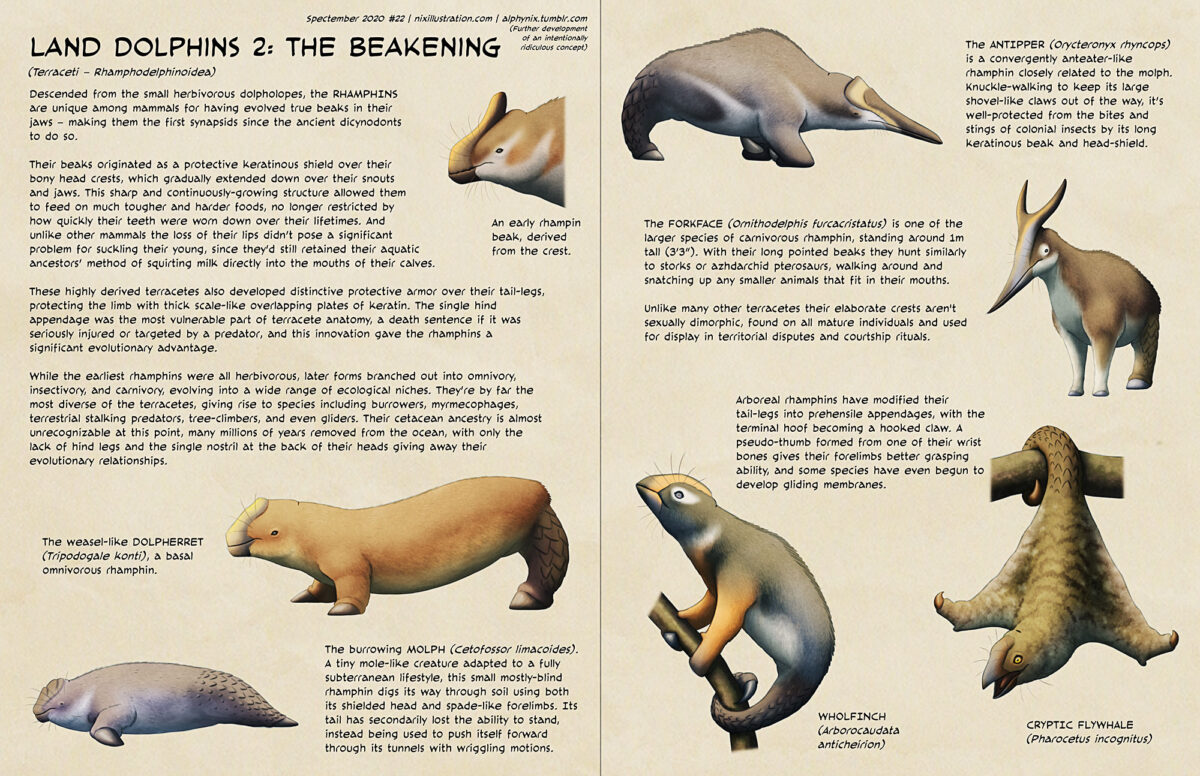And so we finish Spectember as we started… with ridiculous land dolphins!
Transcript for the text on the image under the cut:
PAGE 1
Spectember 2020 #22 | nixillustration.com | alphynix.tumblr.com
(Further development of an intentionally ridiculous concept)
Land Dolphins 2: The Beakening
(Terraceti – Rhamphodelphinoidea)
Descended from the small herbivorous dolpholopes, the RHAMPHINS are unique among mammals for having evolved true beaks in their jaws – making them the first synapsids since the ancient dicynodonts to do so.
Their beaks originated as a protective keratinous shield over their bony head crests, which gradually extended down over their snouts and jaws. This sharp and continuously-growing structure allowed them to feed on much tougher and harder foods, no longer restricted by how quickly their teeth were worn down over their lifetimes. And unlike other mammals the loss of their lips didn’t pose a significant problem for suckling their young, since they’d still retained their aquatic ancestors’ method of squirting milk directly into the mouths of their calves.
These highly derived terracetes also developed distinctive protective armor over their tail-legs, protecting the limb with thick scale-like overlapping plates of keratin. The single hind appendage was the most vulnerable part of terracete anatomy, a death sentence if it was seriously injured or targeted by a predator, and this innovation gave the rhamphins a significant evolutionary advantage.
While the earliest rhamphins were all herbivorous, later forms branched out into omnivory, insectivory, and carnivory, evolving into a wide range and ecological niches. They’re by far the most diverse of the terracetes, giving rise to species including burrowers, myrmecophages, terrestrial stalking predators, tree-climbers, and even gliders. Their cetacean ancestry is almost unrecognizable at this point, many millions of years removed from the ocean, with only the lack of hind legs and the single nostril at the back of their heads giving away their evolutionary relationships.
[Image: the head of a beaked tripod dolphin. It has a head crest covered in a keratinous sheath that extends down its face to cover its snout, forming a bird-like toothless beak.]
An early rhampin beak, derived from the crest.
[Image: a weasel-like tripod dolphin with a blunt beak, short forelimbs, and a long body.]
The weasel-like DOLPHERRET (Tripodogale konti), a basal omnivorous rhamphin.
[Image: a mole-like tripod dolphin with tiny eyes, a blunt beak, and large shovel-like claws on its forelimbs.]
The burrowing MOLPH (Cetofossor limacoides). A tiny mole-like creature adapted to a fully subterranean lifestyle, this small mostly-blind rhamphin digs its way through soil using both its shielded head and spade-like forelimbs. Its tail has secondarily lost the ability to stand, instead being used to push itself forward through its tunnels with wriggling motions.
PAGE 2
[Image: an anteater-like tripod dolphin with high humped shoulders, knuckle-walking forelimbs, and a long narrow bird-like beak.]
The ANTIPPER (Orycteronyx rhyncops) is a convergently anteater-like rhamphin closely related to the molph. Knuckle-walking to keep its large shovel-like claws out of the way, it’s well-protected from the bites and stings of colonial insects by its long keratinous beak and head-shield.
[Image: a tripod dolphin with a long pointed bird-like beak and a large head crest that resembles a two-pronged fork.]
The FORKFACE (Ornithodelphis furcacristatus) is one of the larger species of carnivorous rhamphin, standing around 1m tall (3’3”). With their long pointed beaks they hunt similarly to storks or azhdarchid pterosaurs, walking around and snatching up any smaller animals that fit in their mouths.
Unlike many other terracetes their elaborate crests aren’t sexually dimorphic, found on all mature individuals and used for display in territorial disputes and courtship rituals.
Arboreal rhamphins have modified their tail-legs into prehensile appendages, with the terminal hoof becoming a hooked claw. A pseudo-thumb formed from one of their wrist bones gives their forelimbs better grasping ability, and some species have even begun to develop gliding membranes.
[Image: an arboreal tripod dolphin climbing a branch, gripping on with the pseudo-thumbs on its forelimbs and its prehensile coiled tail.]
WHOLFINCH (Arborocaudata anticheirion)
[Image: an arboreal tripod dolphin with gliding membranes between its forelimbs and body, and its prehensile tail curled around a branch.]
CRYPTIC FLYWHALE (Pharocetus incognitus)

